

Uh oh...
It appears that you're using a severely outdated version of Safari on Windows. Many features won't work correctly, and functionality can't be guaranteed. Please try viewing this website in Edge, Mozilla, Chrome, or another modern browser. Sorry for any inconvenience this may have caused!
Read More about this safari issue.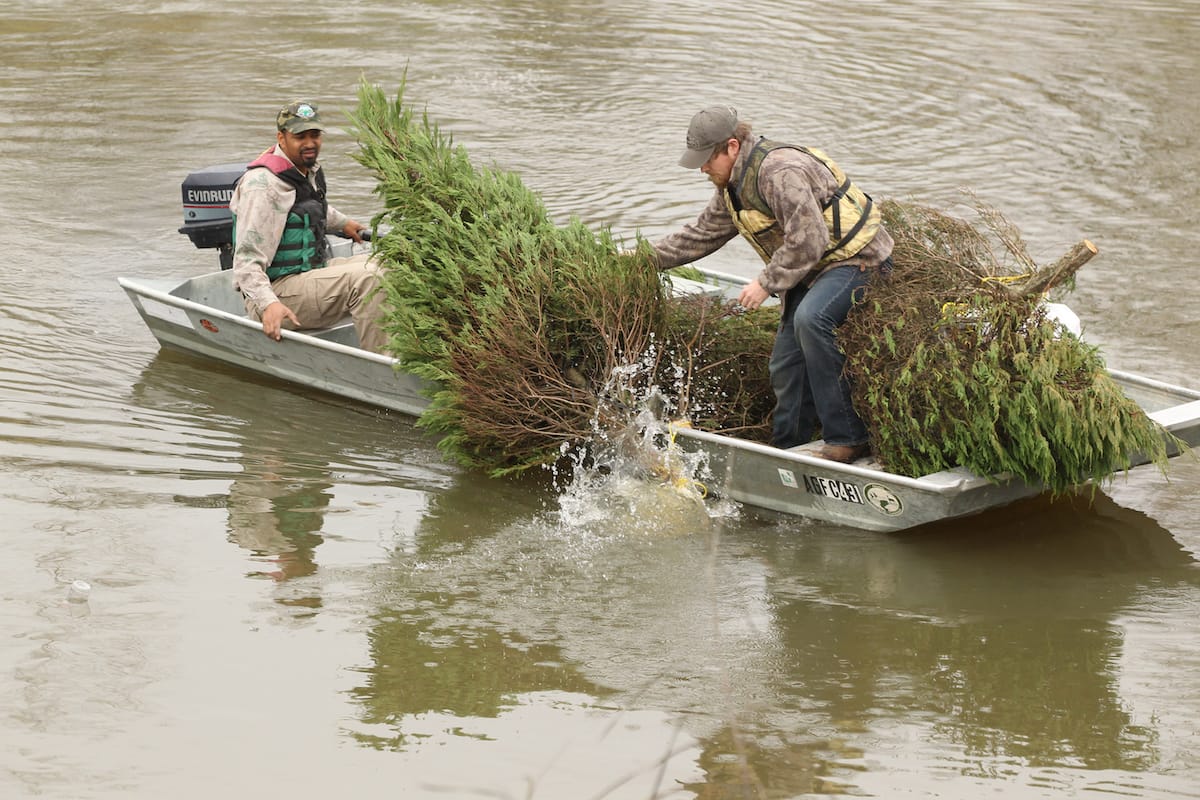

When it comes to the environmental impact of Christmas, it turns out stringing lights and hanging toy soldiers on an artificial tree isn’t necessarily a better choice over chopping down a live one. With programs like the Arkansas Game and Fish Commission’s Christmas Tree Habitat program, I have the opportunity to make a positive contribution to the environment every time I choose a real tree.
Having a real tree has long been an important part of my Christmas experience, as it is for many families. I don’t think I knew artificial Christmas trees existed until I moved to Arkansas and as an adult, became more concerned with my environmental footprint.
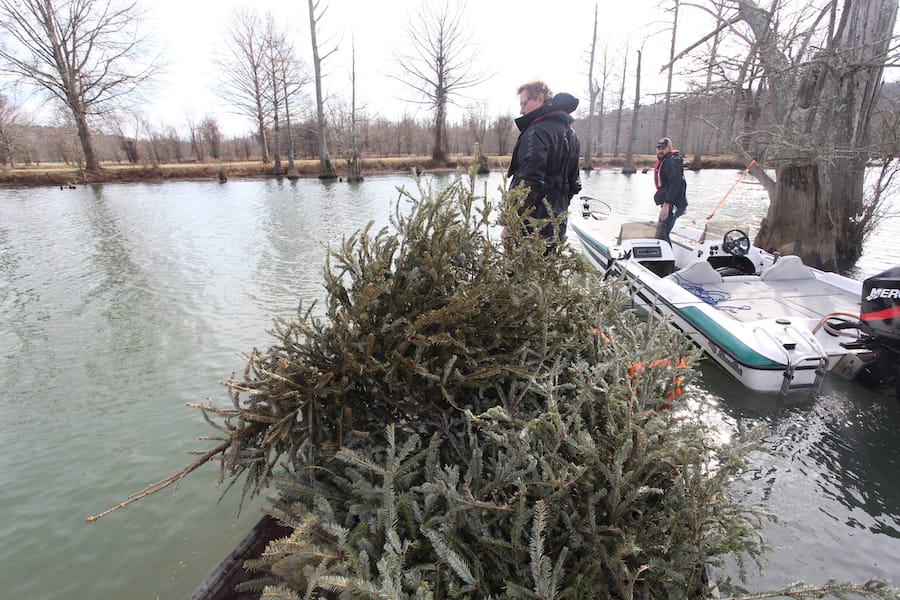
Sinking Christmas Trees on the Little Maumelle River in Little Rock, Ark. Photo provided by AGFC.
Why Artificial Trees Aren’t Necessarily Better for the Environment
Because of their reusability, artificial trees seem like an excellent choice. But due to the combination of materials, these trees can’t be always be recycled. When that fake fir turns ragged, the plastic and metals manufactured into green branches are tossed out into the landfills or illegally dumped onto an earth that can’t do anything but absorb chemicals leaching into the ground.
Research suggests for an artificial tree to have a benefit over choosing a real tree, it must be reused for as many as 20-30 years, an unlikely scenario for most households.
Those Live Christmas Trees Come With Benefits
Until a real tree is cut, it cleans the air, provides habitat and shade, prevents erosion and collects groundwater. When it biodegrades or burns, the tree is considered carbon-neutral because its carbon emission is equal to what it removed from the air while alive.
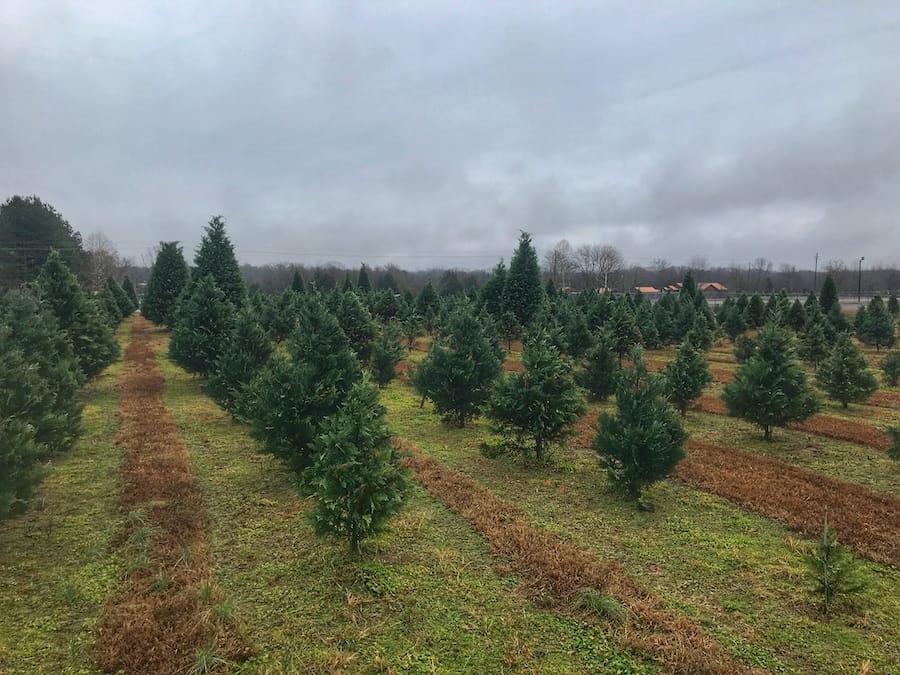
Photo by Julie Kohl
Purchasing a real tree has a direct benefit to the local economy. Christmas Tree Farms all over Arkansas are run by families who depend on people’s holiday tree-hunting tradition to earn a living. To ensure product year after year, trees are replanted often at a higher rate than they are cut down.
After being cut and decorated and enjoyed by families, these trees can give back to nature long after Christmas has faded into a new year. The Arkansas Game and Fish Commission made this possible when it launched its Christmas tree program in 2006. This process benefits both anglers and fish by giving trees a new life as a fish habitat.
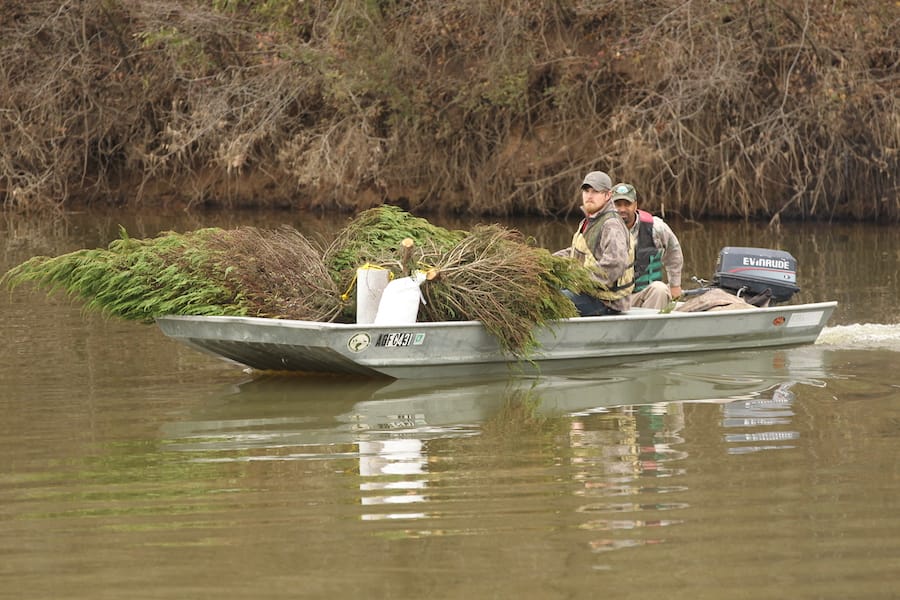
Sinking Christmas trees as fish habitats in a channel off the Arkansas River. Photo provided by AGFC.
Christmas Trees for Fish
In a program reminiscent of “leave a penny, take a penny” containers on the gas station counters, the commission is calling on Arkansans. Christmas trees will be collected at various pre-approved locations through the end of January (see the list below). These trees will benefit fish habitats in lakes and bodies of water across The Natural State.
How does it work?
Anyone with a real Christmas tree may take it to a drop-off location and leave it near the indicated boat ramp. Anglers may then collect the trees and place them into designated waters to create habitat coverage for fish.
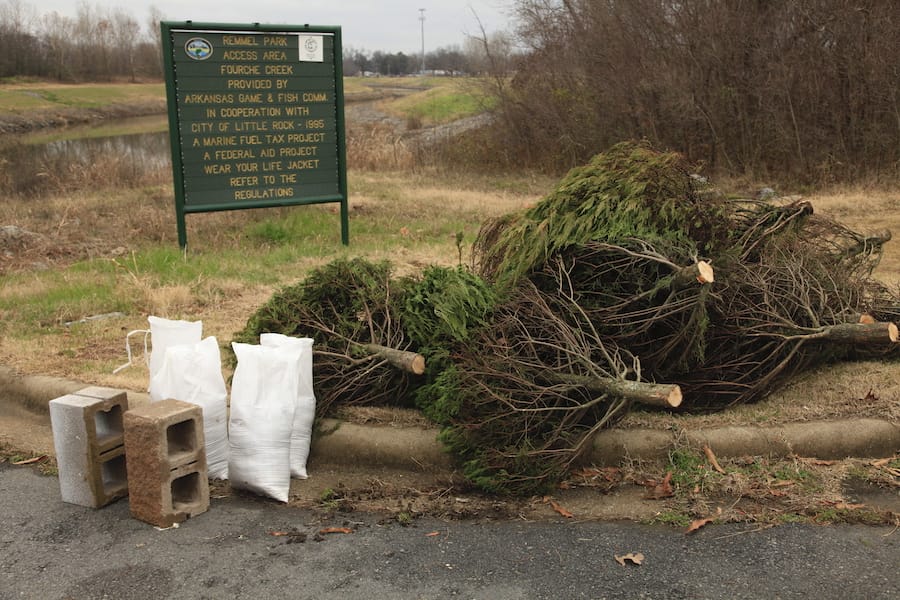
Photo provided by AGFC.
Randy Zellers, the commission’s assistant chief of communications said, “The number one benefit of this program is that it creates a place for anglers and fish to meet.” Anglers can use the trees to create their own fishing honey holes.
“The second benefit is the habitat potential for fish. Especially in smaller lakes and for predator species like bass and crappie, these artificial habitats provide them a spot to hide so they may ambush their prey.”
As the trees break down in the water, they will also create algae and provide a small boost of nutrients to the smaller fish species.
Zellers offered this advice for those participating in the program:
For those wishing to donate trees:
- Only REAL trees may be donated.
- Remove all ornaments, tinsel, lights and other man-made materials from the trees before dropping them off.
- Drop off at one of the commission pre-approved locations or check with the owners of the lake or body of water before leaving trees behind.
- Do not block the boat ramps when donating trees.
For those wishing to sink trees for fish:
- Always check over trees to make sure that they meet the program requirements.
- Always check to make sure the location allows habitats to be sunk.
- Take several trees and tie them together to create a more abundant habitat.
- Anglers must provide their own cinder blocks and rope. Polyester rope will last longer than cotton rope.
- Consider adding trees to an existing habitat to rebuild it.
- Sinking trees to a depth of 12-25 feet is ideal for crappie. Bass habitats can be a little shallower.
- Mark the GPS location of your habitat so you can return to it later to fish.
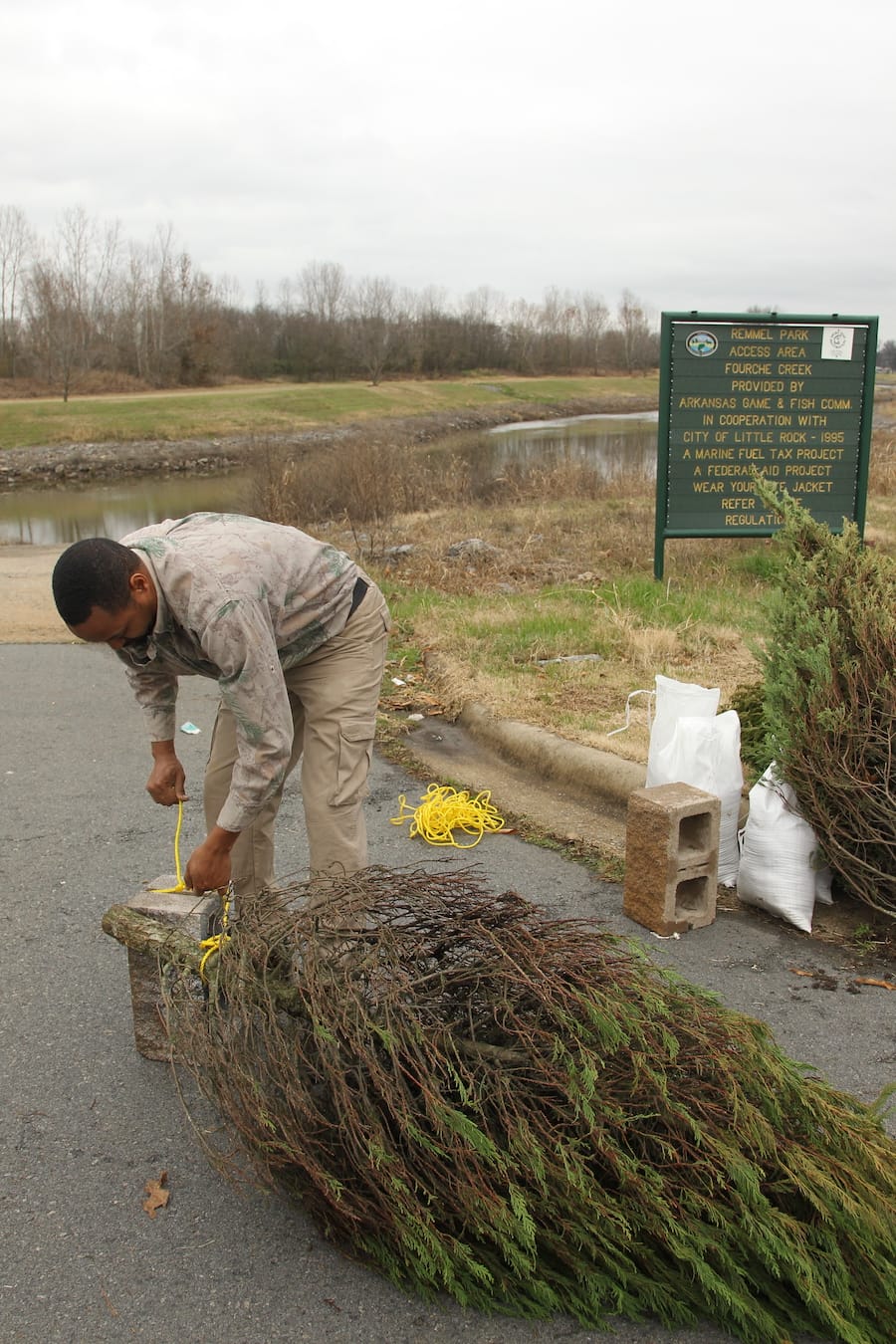
Photo provided by AGFC.
Zellers estimates that each year, over 1000 trees are collected and added to fish habitats across the state. Real trees, even non-native ones, can provide a valuable benefit to fish and anglers. Any trees not claimed and sunk by anglers will be collected by commission personnel and dropped into the bodies of water where they were left. No Christmas tree is wasted, and you can feel good about deciding to purchase a real tree.
2021 AGFC Christmas Tree Drop-off Locations
Trees should be dropped off before the end of January.
Central/Eastern Arkansas
- Greers Ferry Lake – Sandy Beach (Heber Springs), Devils Fork Recreation Area and Choctaw Recreation Area (Choctaw-Clinton)
- Lake Conway – Lawrence Landing Access
- Harris Brake Lake – Chittman Hill Access
- Lake Overcup – Lake Overcup Landing
- Lake Barnett – Reed Access
- Lake Hamilton – Andrew Hulsey State Fish Hatchery Access Area
- Cook’s Lake – Potlatch Conservation Education Center at 625 Cook’s Lake Road, Casscoe, or the bus lot across from Grand Avenue United Methodist Church in Stuttgart
- Horseshoe Lake – Pat and Nancy Bonds Access
- Lake Pickthorne – Boat Ramp Access
Northeast Arkansas
- Jonesboro – Craighead Forest Park Lake boat ramp
- Lake Bono – Boat Ramp Access
- Lake Walcott – Crowley’s Ridge State Park Boat Ramp Access
- Lake Charles – Boat Ramp Access
- Lake Poinsett – Dam Boat Ramp Access
Northwest Arkansas
- Beaver Lake – Highway 12 Access and AGFC Don Roufa Hwy 412 Access
- Lake Elmdale – Boat Ramp Access
- Bob Kidd Lake – Boat Ramp Access
- Crystal Lake – Boat Ramp Access
Southeast Arkansas
- Lake Chicot – Connerly Bayou Access Area
- Cane Creek – State Park Access
- Cox Creek Lake – Cox Creek Lake Public Access
- Lake Hamilton – Andrew Hulsey State Fish Hatchery Access Area
Southwest Arkansas
- Bois d’Arc Lake – Kidd’s Landing or Hatfield Access
- Millwood Lake – Cottonshed, White Cliffs Recreation Areas and the Millwood State Park ramp on the point
- Dierks Lake – Jefferson Ridge South Recreation Area
- DeQueen Lake – Any U.S. Army Corps of Engineers boat ramp
- Gillham Lake – Any U.S. Army Corps of Engineers boat ramp
- Lake Greeson – New Cowhide Cove and Self Creek Recreation areas
- Camden – AGFC Regional Office on Ben Lane
- Upper White Oak Lake – Upper Jack’s Landing
- Magnolia – Columbia County Road Department Yard on Highway 371
- El Dorado – City recycling center drop-offs: one behind Arby’s and one on South Jackson
- Smackover – Recycling Drop-Off Center (these will be transported to El Dorado)
- South Fork Lake – South Fork Lake Access
- Terre Noire Lake – Terre Noire Lake Access
- Hope – Arkansas Game and Fish Commission Regional Office on Hwy. 67 East
For more information, you can visit AGFC.com.
We do the work.
You check your email.
Sign up for our weekly e-news.
Get stories sent straight to your inbox!









Like this story? Read more from Julie Kohl
Clinton is a popular spot for Arkansans to refuel their cars and their...
Nestled in the heart of the Ouachita Mountains, Mount Ida proudly holds...
There’s something about reading outdoors that makes a good book even...
Join the Conversation
Leave a Comment